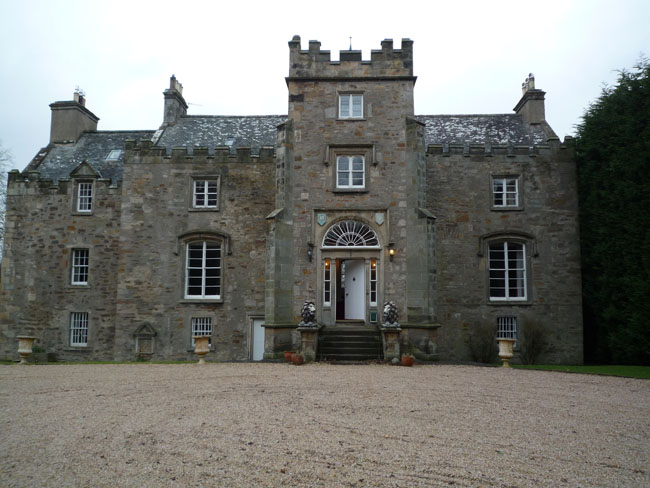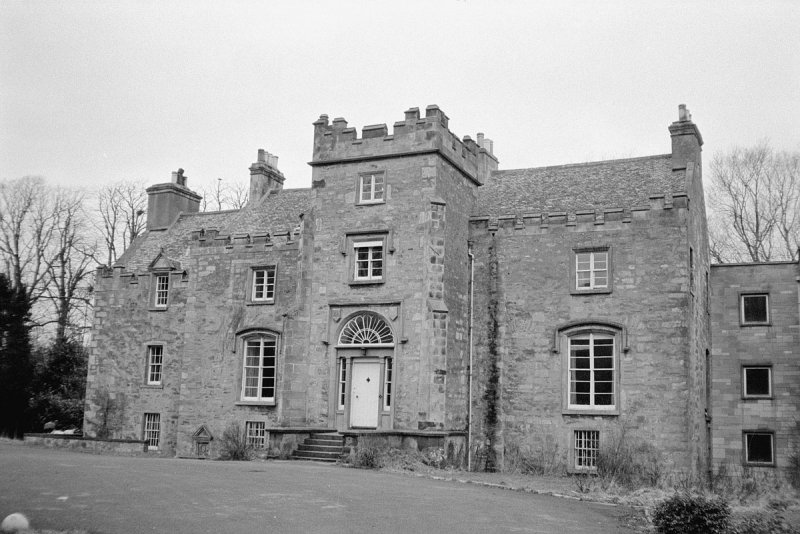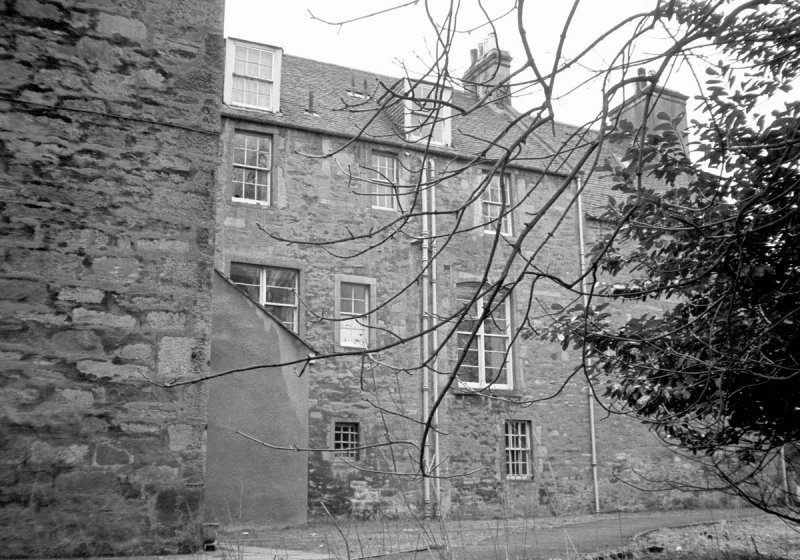 |
The History of Foulstruther
Built on solid rock, Foulstruther Castle is a
striking and imposing building, and although retaining much of it's original
features and design, the tower-house castle was cut-down and the upper storey
removed and somewhat re-designed, adding a crenelated parapet that reflected the
original, and is no longer called by it's historical name, and now called
simply, Woodhall House.
The original estate of Foulstruther was acquired by the Seton's in the early
16th century and was a favoured gift from Lady Janet Hepburn to her grandson
John Seton, the second son of George, 6th Lord Seton. Upon the temporary
absence of his brother, the famed George 7th Lord Seton, in the low countries
where for a time it was thought that he had died, John Seton assumed the Titles
and Honours of Seton and sat in the Upper House as Lord Seton. Upon his
brother's return, he was forced to relinquish the patronymic position, and which
costs at his won expense forced his selling of the Foulstruther Estate, and he
resided on his Royal gifted Estate of Cariston, in Fife.
The lands were later re-acquired by the Earl of Winton, and bestowed on his
younger son, Sir Alexander Seton, who became temporarily 'of Foulstruther'.
With Sir Alexander Seton's assumption of the Earldom of Eglinton and eventual
succession as the 6th Earl of Eglinton, he sold the Estate of Foulstruther, and
which and Barony was eventually broken up.
The house as it is now, is divided into three parts (one four storey
section to the north, and two six storey sections to the south) the walls are up
to 6 feet thick and the southern gable end has 50 feet turrets in each corner.
By 1791, there was a little village in the vicinity of the castle. The 145
inhabitants came from mostly mining families and their children were taught in
the nearby schoolhouse. This was not the isolated monument that exists today but
a thriving community centred on an important piece of defensive architecture.
Woodhall House is a Scottish mansion house, first
recorded in 1707. It was also an institution run by the Society of Jesus in the
late 20th century. It is situated off Woodhall Road in the Juniper Green area of
Edinburgh, Scotland and is a category B listed building.
The
Foulis baronets
Juniper Green is first recorded in 1707, when only Baberton House and Woodhall
House were the only buildings in the area.The owner at that time was a William Foulis of the
Foulis baronets who inherited Woodhall House from Sir John Foulis. Eventually, it passed to Sir James Foulis who owned
Woodhall from 1796 to his death in 1842. The house continued to pass down the
Liston-Foulis baronets of Colinton until it was sold to Professor Stanley
Patrick Davidson.
In 1921, Professor Davidson became a member of the Royal College of Surgeons. He
was President of the Royal College of Physicians in Edinburgh from 1953 to 1957.
In 1959, he retired and Woodhall House was sold again.
Society of Jesus.
In 1959, Woodhall House was bought for £8000 by the Society of Jesus. It
originally served as a retreat house for weekend retreats in Ignatian
spirituality for working mens' sodalities and parish groups as well as being the
novitiate for the proposed Scottish Province of Jesuits. They intended to create
a Scottish Province of Jesuits that would extend their pre-existing works in
Scotland and would also build a link between Scottish Jesuits and Jesuits
working abroad such as in, what was then known as, British Guyana.
The Jesuits opened Woodhall House as a novitiate for Scotland in early September
1963. Fr. James Christie SJ from Sacred Heart Church, Edinburgh was the first
rector at the novitiate and the prefect of studies was the notable theologian
and hymnwriter Fr James J. Quinn SJ. The first Mass in the novitiate chapel was
celebrated by the Archbishop of St. Andrews and Edinburgh, Cardinal Gordon Gray.
However in 1964, all the Jesuit novices in Britain were sent to the house for
their training.
In 1970, the Jesuit novitiate left Woodhall House and the novices were
transferred to Loyola Hall outside Liverpool. The Society of Jesus went on to
sell Woodhall House in 1976 to a private owner.
Soon after the Jesuits sold the property, the house was let out to students of
Edinburgh Napier University and Moray House School of Education. In 1982, it was
converted into 17 private residential flats.
 Woodhall House stands on the south bank of the
Water of Leith, protected by mature trees. It was to become the big house of the
village of Juniper Green. Woodhall House stands on the south bank of the
Water of Leith, protected by mature trees. It was to become the big house of the
village of Juniper Green.
 Woodhall was originally Crown land, part of the Barony of Redhall. The estate
was first mentioned in a list of Charters of David II in 1329 and was leased to
Alexander Menzies of Woodhall who was one of Robert the Bruce's stalwart
supporters. In 1374 Woodhall was settled on Sir William Cunningham of Kilmaurs
by Murdoch Stewart, Earl of Fife. In 1400 the Charter was confirmed by Robert
Stewart Duke of Albany and Governor of Scotland. Sir William Cunningham married
the eldest of the co-heiresses of Sir Robert Denniston and received the Baronies
of Redhall and Colinton. Woodhall was originally Crown land, part of the Barony of Redhall. The estate
was first mentioned in a list of Charters of David II in 1329 and was leased to
Alexander Menzies of Woodhall who was one of Robert the Bruce's stalwart
supporters. In 1374 Woodhall was settled on Sir William Cunningham of Kilmaurs
by Murdoch Stewart, Earl of Fife. In 1400 the Charter was confirmed by Robert
Stewart Duke of Albany and Governor of Scotland. Sir William Cunningham married
the eldest of the co-heiresses of Sir Robert Denniston and received the Baronies
of Redhall and Colinton.
One of the highlights of the house is the plaster ceiling dating from 1630. The
ceiling features St Andrew's Cross, the Thistle, the fleur de lys, a rose, crown
and scepter, a lion rampant and the motto "Nobis haec invicta miserunt 108
proavi" which roughly translates to "To us 108 ancestors have sent these
unconquered things."
The house and lands stayed in the Cunningham family until near the end of the
seventeenth century when Sir John Foulis of Ravelston acquired Woodhall. The
name Foulis is reckoned to be of Norman origin after incomers who settled in
Scotland in the reign of Malcolm III (1056 - 1092). Their heraldic emblem was
three bay leaves. Others think it comes from the Gaelic word "foghlais" which
means "rivulet".
The Foulis family found themselves in high places in the Scottish Court and held
lands in Perthshire, Angus and Ross and Cromarty. They claim royal descent with,
included in their family tree, Robert the Bruce, Edward I of England, Philip IV
of France, Edward the Black Prince and James I of England and Scotland.
Sir John Foulis comes down through history in part due to his meticulous account
books in which he kept a record of his spending. He was a happy man, kindly
husband to four wives and father to fifteen children. He was born in 1638 and he
died in 1707 just as the village of Juniper Green was mentioned for the first
time in a written document.
|

